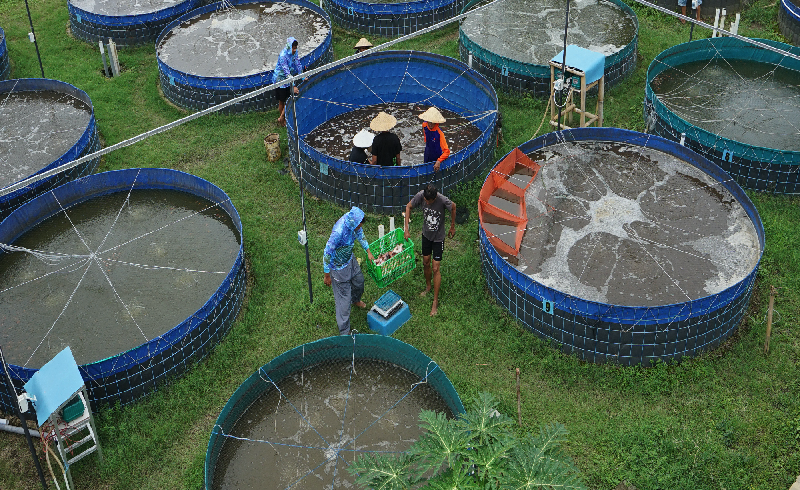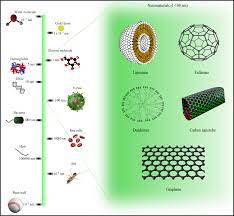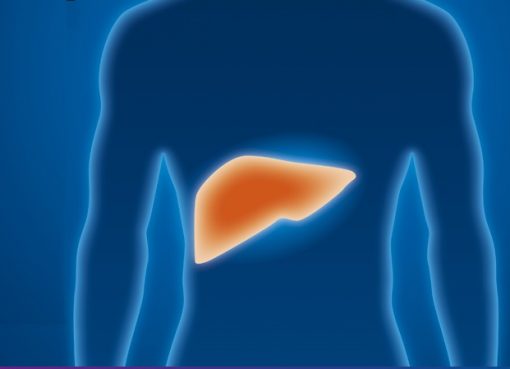Sugandha Kashyap
Department of Aquaculture
College of Fisheries, Assam Agricultural University, Raha
Email ID: sugandha16kashyap@gmail.com
Biofloc Technology (BFT) is an advanced, “climate-smart technology” that enhances feed efficiency, promotes water quality management, and recycles feed to boost fish production in a short time. In comparison to water exchange systems, which need 50–75% water exchange daily, the biofloc technology can conserve water by a factor of 14 (Dauda et al., 2018a). According to Emerenciano et al. (2017), biofloc technology represents the next “blue revolution” in aquaculture. Biofloc, rich in bacterial protein and enhanced with probiotics, offers a highly nutritious environment for culturing species.
The major goal of BFT is to minimise the buildup of feed-borne harmful nitrogen compounds (NH3, NO2, etc.) by encouraging heterotrophic microorganisms and adjusting the carbon/nitrogen ratio (C:N) (Avnimelech, 2009). Common carp, channel catfish and Nile tilapia have all been successfully cultured in systems enriched with biofloc.
Selection criteria for species used in biofloc system
- Biofloc system requires species that are able to directly consume the flocs and derive the nutritional benefits from them.
- Species which can tolerate high levels of solid concentration in water are suitable.
- Species that can tolerate a low level of water quality are preferred.
Most suitable species for biofloc system are –
- Air-breathing fish – Singhi, Magur, Pabda, Anabus/Koi, Pangasius
- Non-air-breathing fish – Common carp, Rohu, Tilapia, Milkfish
- Shellfishes like shrimps and prawns
The finfish culture using BFT has been successful in the Asian continent to a huge extent. Top shrimp players in continental Asia have shifted to BFT. Although the potential effect of BFT with respect to fish and shellfish breeding is not clearly known, several studies have reported positive effects of biofloc nutrition in ovary development and enhancement of spawning in broodstock (Cavalli et al., 2012). It is successfully used for the nursery phase of shrimp species like Litopenaeus vannamei, Penaeus monodon and Farfantepenaeus species. Tilapias are considered to be the most successful fish farmed using BFT due to its filter-feeding and grazing mechanism.
The biodiversity of fish is said to be most diverse in the north-eastern states of India. There are about 300 fish species in the north-eastern part of India, which are divided into 114 genera, 37 families, and 10 different orders and 60% of them are purely ornamental (Singh et al., 2021). Assam, Manipur, and Tripura, with their rich fish consumption history and abundant resources, have significant potential for sustainable aquaculture but face challenges like fish escapes during flood seasons. Biofloc’s eco-friendly and sustainable approach enables the cultivation and export of indigenous northeast fish species, offering significant benefits to farmers.
Shrimps and Prawn: The prawn farming industry is embracing the beneficial microbiota-based biofloc culture. Penaeus vananmei and P. mondon are successfully cultured using BFT. Probiotics are well recognised as crucial elements in prawn farming and hence BTF can be highly useful for their culture. It is feasible to cultivate marine species like P. vananmei in inland zones using BFT with little to no water exchange and no harm to the surrounding ecology (Avnimelech, 2015). Recently, BFT has been effectively used in P. vananmei grow-out cultures in low-salinity environments. Proteobacteria and Bacteroidetes were found to be the first and second most abundant phyla in the mature biofloc water culturing prawns and tilapia, according to previous studies. In terms of growth metrics, shrimps raised at a low stocking density (400 PL/m3) is reported to performed well in BFT.
Common carp: Biofloc technology reduces ammonia, nitrite, and nitrate levels in intensive common carp cultivation, making it sustainable and profitable through improved FCR, feed utilization, and minimal nutrient load. When raised in an intensive BFT environment, the omnivorous common carp is able to digest bioflocs, and endure high concentrations of suspended matter in the water, low concentrations of oxygen, and stress (Najdegerami et al., 2016). In a medium-stocking density biofloc system, fish, like common carp, show improved growth, feed utilization, digestive enzyme activity, immune status, and overall health, with better resistance to acute stress compared to those in close confinement.
Indian major carps (rohu, catla, and mrigal): BFT was used to cultivate Labeo rohita in monoculture, and the results show an excellent growth rate of 87.5% more than the corresponding control treatment and no mortality throughout the 90-day culture period (Mahanand et al., 2013). Biofloc with 30-35% crude protein is appropriate for carp culture. A polyculture synergy of IMC can be used to maximise the benefits of BFT. Compared to other species, catla can graze on floating bioflocs more easily, which may be the primary factor in catla’s rapid growth in BFT. Deb et al., 2020 demonstrated how biofloc can be used effectively to grow IMC (polyculture) in semi-indoor conditions with 38% less water usage and also determined that the nutritional value of harvested biofloc was suitable for IMC to utilise as a supplemental feed.
Catfish (Claria batrachus, C. gariepinus, Pangasius): Catfish is one of the most widely consumed live fish in Asia. Since the catfish is a labyrinth fish, it may be grown utilising high-density technologies, such as the biofloc technology. Biofloc-based high-density catfish cultivation is a lucrative industry that may also be used in small and large-scale home businesses.
The ability of the air-breathing catfish like magur, singhi, and facultative air-breathing Pangasianodon hypophthalmus (stripped catfish) to take up atmospheric oxygen and a comparatively stronger tolerance for low water quality circumstances are two factors that contribute to their high survival rate in BFT. Previous studies, specifically on African catfish, demonstrated that fish raised with biofloc technology grew and survived better than fish raised in ponds and tanks.
Tilapia: Tilapia are perfectly suited to biofloc environments. The robust, stable fish develop and thrive in crowded environments, and the filter-feeding herbivores adapt to the harvest of bioflocs floating in the water. Recycling feed and reducing water exchange are significant to tilapia farming. Intensive tilapia BFT ponds are rather small, ranging in size from 100 to 1000 m2, mostly because it is challenging to mix a huge body of water perfectly.
Trouts and mahseers: Trouts, especially brown trout, rainbow trout, and golden mahseer, which are naturally found in the Siang River flowing through Arunachal Pradesh, have the potentiality to be cultured by using BFT. Although there is no clear information about the development of biofloc systems in culturing these species yet but there is possibility for it in the near future.
REFERENCES
Adineh, H., Naderi, M., Jafaryan, H., Khademi Hamidi, M., Yousefi, M. and Ahmadifar, E. (2022). Effect of stocking density and dietary protein level in biofloc system on the growth, digestive and antioxidant enzyme activities, health, and resistance to acute crowding stress in juvenile common carp (Cyprinus carpio). Aquaculture Nutrition.
Basuki, F., Yuniarti, T., Harwanto, D. and Susilowati, T. (2018). Analysis of growth performance and benefits of a high density catfish Clarias gariepinus Burchell culture in biofloc system. In IOP Conference Series: Earth and Environmental Science (Vol. 137, No. 1, p. 012026). IOP Publishing.
Das, S. K. and Mandal, A. (2021). Supplementation of biofloc in carp (Cyprinus carpio var. communis) culture as a potential tool of resource management in aquaculture. Aquatic Living Resources, 34: 20.
Dauda, A. B., Romano, N., Ebrahimi, M., Teh, J. C., Ajadi, A., Chong, C. M., … & Kamarudin, M. S. (2018). Influence of carbon/nitrogen ratios on biofloc production and biochemical composition and subsequent effects on the growth, physiological status and disease resistance of African catfish (Clarias gariepinus) cultured in glycerol-based biofloc systems. Aquaculture, 483: 120-130.
Deb, S., Noori, M. T. and Rao, P. S. (2020). Application of biofloc technology for Indian major carp culture (polyculture) along with water quality management. Aquacultural Engineering, 91: 102106.
Diatin, I., Shafruddin, D., Hude, N., Sholihah, M. A. and Mutsmir, I. (2021). Production performance and financial feasibility analysis of farming catfish (Clarias gariepinus) utilizing water exchange system, aquaponic, and biofloc technology. Journal of the Saudi Society of Agricultural Sciences, 20(5): 344-351.
Mahanand, S. S., Moulick, S. and Rao, P. S. (2013). Water quality and growth of Rohu, Labeo rohita, in a biofloc system. Journal of applied Aquaculture, 25(2): 121-131.
Pratiwi, R., Hidayat, K. W. and Sumitro, S. (2020). Production performance of catfish (Clarias gariepinus burchell, 1822) cultured with added probiotic Bacillus sp. on biofloc technology. Journal of Aquaculture and fish Health, 9(3): 274.
Singh, M. K. and Boruah, D. (2022). An Insight on the Prospects of Biofloc Technology (BFT) in the North-Eastern States of India. Asian Journal of Biological and Life Sciences, 11(1): 21.




